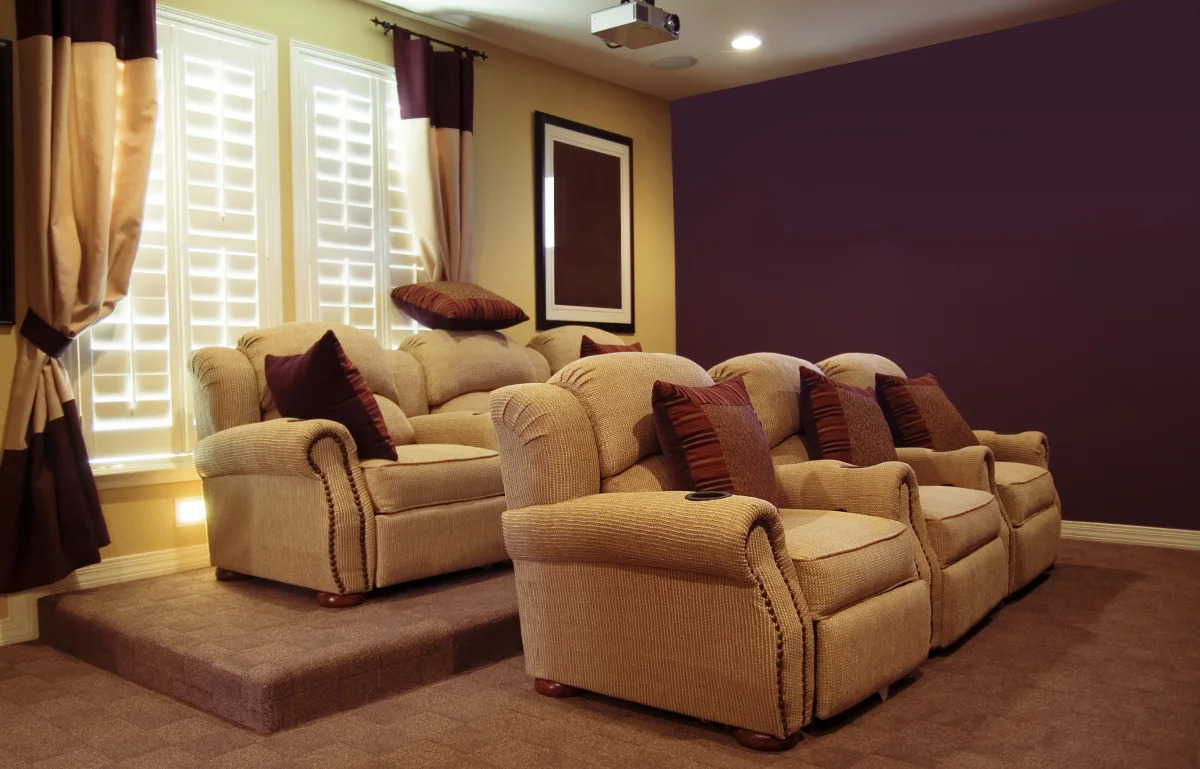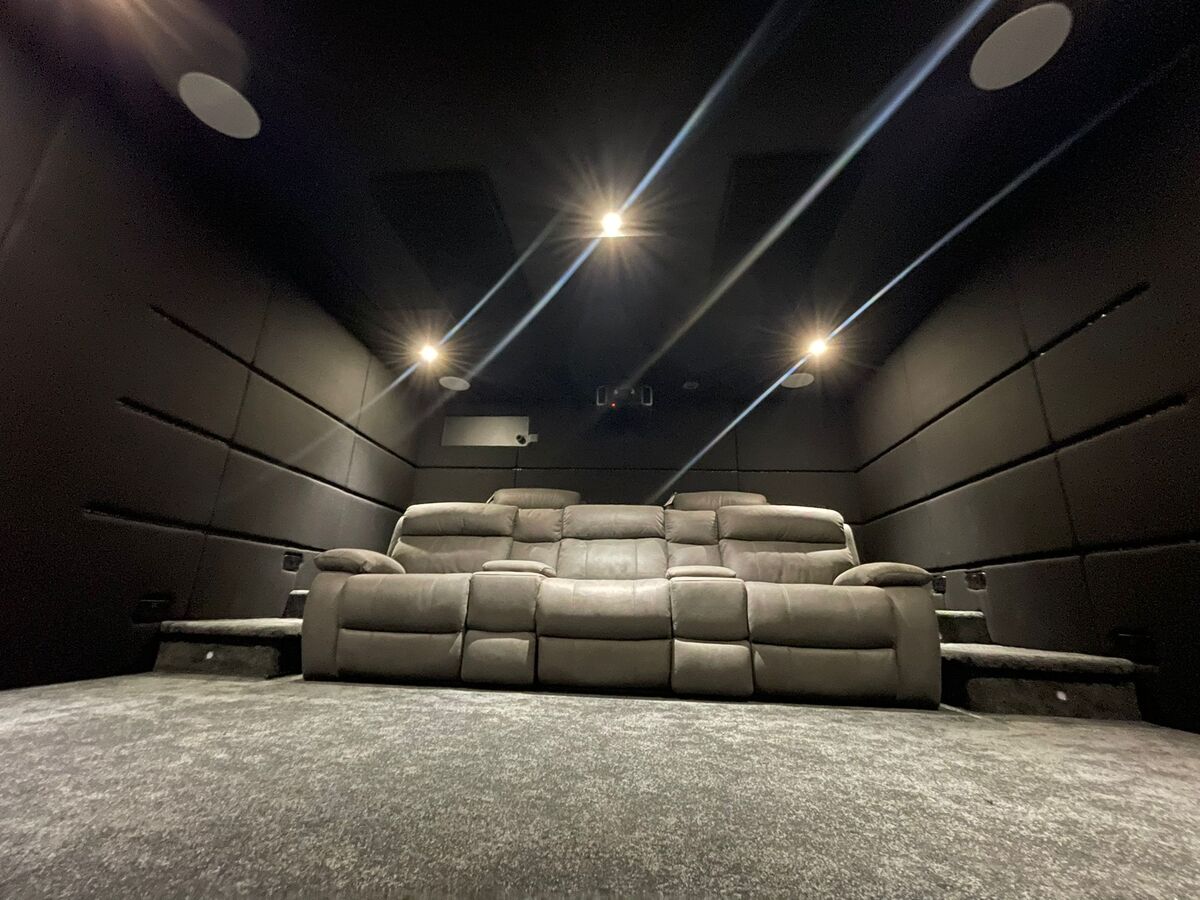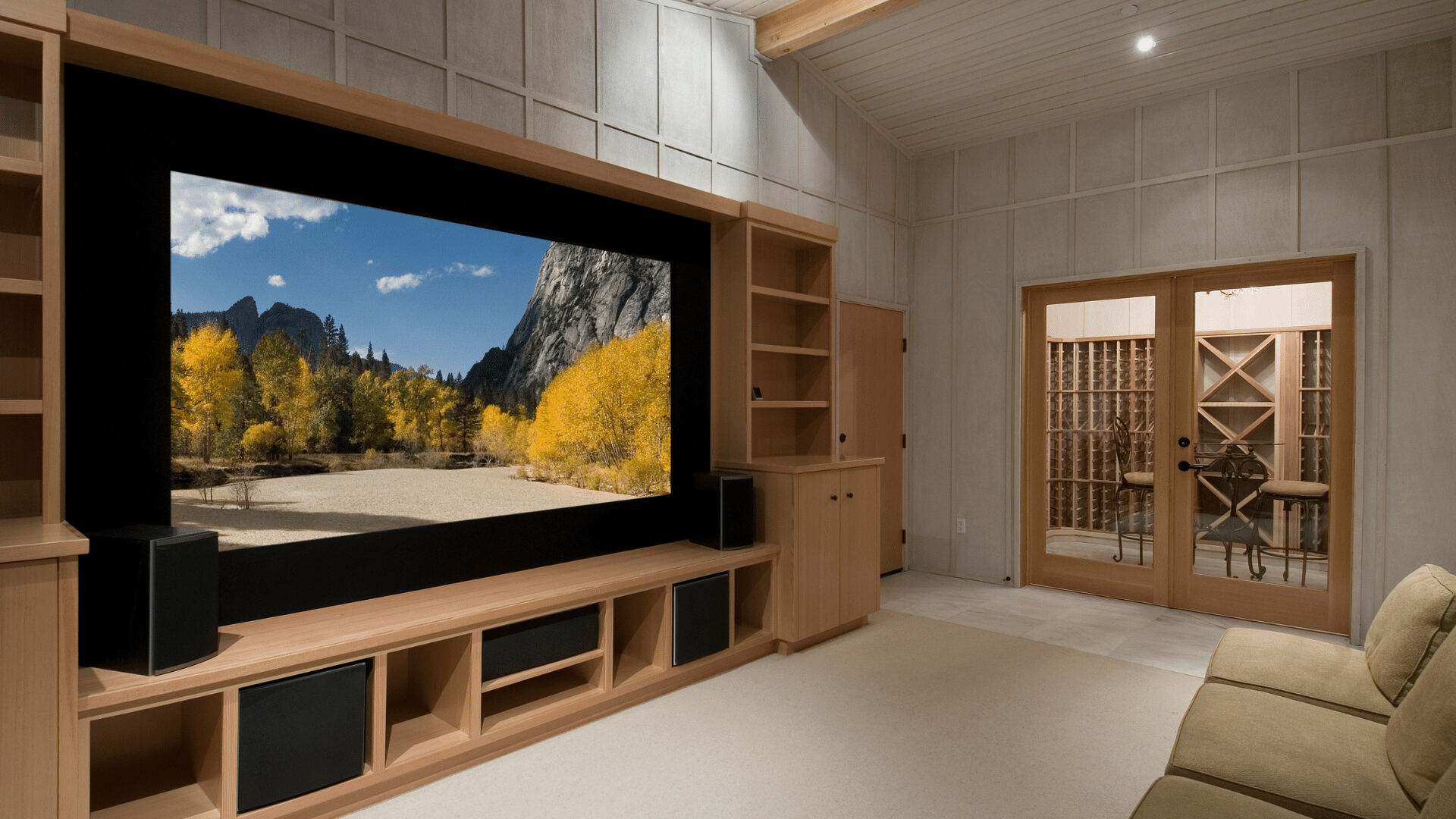Home>Technology>Home Entertainment Systems>How To Build A Home Theater Riser


Home Entertainment Systems
How To Build A Home Theater Riser
Modified: August 28, 2024
Learn how to build a home theater riser to enhance your home entertainment system. Create the ultimate movie-watching experience with our step-by-step guide.
(Many of the links in this article redirect to a specific reviewed product. Your purchase of these products through affiliate links helps to generate commission for Storables.com, at no extra cost. Learn more)
Introduction
Creating a captivating home theater experience involves more than just a high-quality sound system and a large screen. It's about transforming a room into a space that immerses you in the magic of cinema. One essential element that can elevate your home theater setup is a well-designed and sturdy home theater riser. A home theater riser not only adds a touch of luxury to your entertainment space but also serves practical purposes, such as providing better viewing angles and optimizing acoustics.
In this comprehensive guide, we will walk you through the step-by-step process of building a home theater riser. Whether you're a seasoned DIY enthusiast or a novice looking to embark on your first home improvement project, this guide will equip you with the knowledge and confidence to create a professional-grade riser that enhances your home theater experience.
A well-constructed home theater riser not only elevates the seating arrangement but also adds a sense of grandeur to the room. By following the steps outlined in this guide, you'll have the opportunity to customize the riser to suit your specific space and preferences. From measuring the area to selecting the right materials and tools, each step is crucial in ensuring that the end result is a durable, stable, and visually appealing addition to your home theater.
As we delve into the intricacies of building a home theater riser, keep in mind that attention to detail and precision are key. The satisfaction of enjoying your favorite movies, TV shows, and games in a meticulously crafted home theater space will make the effort well worth it. So, roll up your sleeves, gather your tools, and let's embark on this exciting journey to create a home theater riser that will be the envy of all your friends and family.
Key Takeaways:
- Building a home theater riser involves precise measurements, sturdy materials, and careful construction. It enhances the entertainment space, providing a luxurious and immersive cinema experience for you and your loved ones.
- The construction of a home theater riser requires attention to detail and craftsmanship. It transforms a room into a captivating entertainment environment, where every movie night becomes an unforgettable adventure.
Step 1: Measure the Space
Before diving into the construction of your home theater riser, it's crucial to start with precise measurements of the designated area. This initial step lays the foundation for the entire project, ensuring that the riser fits seamlessly into your home theater space.
Begin by identifying the location where the riser will be placed. Take accurate measurements of the length, width, and height of the area. Consider the number of seats the riser will accommodate and the optimal viewing angles for the audience. Keep in mind that the riser should not obstruct the view of the screen for individuals seated in the front row.
Once you have the measurements, it's advisable to create a detailed plan or sketch of the space, indicating the dimensions and any existing obstacles, such as vents or electrical outlets. This plan will serve as a valuable reference throughout the construction process, ensuring that the riser aligns with the room's layout and design.
Additionally, consider the flooring of the room. If the floor is not level, you may need to make adjustments to ensure that the riser sits evenly and securely. Use a level to check for any discrepancies in the floor's surface and make note of any areas that require leveling.
Furthermore, take into account the overall aesthetic of the room. The design of the riser should complement the existing decor and contribute to the cohesive look of the home theater. Whether you opt for a sleek, modern design or a more traditional style, the measurements and planning phase will guide the subsequent stages of the construction process.
By meticulously measuring the space and considering all relevant factors, you set the stage for a successful home theater riser project. This attention to detail at the outset will streamline the construction process and ensure that the final result seamlessly integrates into your home theater, enhancing both its functionality and visual appeal.
Step 2: Gather Materials and Tools
To embark on the construction of your home theater riser, you'll need a carefully curated selection of materials and tools to bring your vision to life. Here's a comprehensive list to ensure you have everything you need for a successful build:
Materials:
-
Lumber: Select high-quality, sturdy lumber for the construction of the base frame and support beams. Opt for lumber that can withstand the weight of the riser and provide stability. Common choices include 2×4 or 2×6 boards, depending on the dimensions of your riser.
-
Plywood: Choose plywood for the top surface of the riser. The plywood should be thick enough to support the weight of seating and individuals while maintaining durability. Consider the dimensions of the plywood based on the size of your riser.
-
Screws and Nails: Ensure you have an ample supply of screws and nails to secure the various components of the riser. Select screws designed for use with lumber and plywood to ensure a secure and long-lasting construction.
-
Wood Glue: Opt for a high-quality wood glue to reinforce the joints and connections between lumber pieces. This will add an extra layer of strength to the riser's structure.
-
Carpet or Flooring Material: If you plan to cover the riser with carpet or a specific flooring material, ensure you have enough to cover the entire surface area. Consider the color and texture of the material to complement the overall aesthetic of your home theater.
-
Primer and Paint (Optional): If you intend to paint or prime the riser to match the room's decor, have the necessary supplies on hand. Choose paint or primer suitable for the type of wood used in the construction.
Tools:
-
Circular Saw or Miter Saw: A reliable saw is essential for cutting lumber and plywood to the precise dimensions required for the riser. A circular saw or miter saw will facilitate accurate and clean cuts.
-
Drill and Drill Bits: A power drill with a selection of drill bits is necessary for creating pilot holes and securing screws during the assembly process.
-
Level: Ensure you have a level to confirm the evenness of the riser during construction. This tool is crucial for achieving a stable and balanced final product.
-
Tape Measure and Carpenter's Square: Accurate measurements are paramount in the construction of the riser. A tape measure and carpenter's square will aid in achieving precision at every stage of the build.
-
Hammer and Rubber Mallet: These tools will be useful for securing nails and making adjustments to the components of the riser.
-
Safety Gear: Prioritize safety by having protective gear such as goggles, gloves, and a dust mask to safeguard yourself during the construction process.
By gathering the necessary materials and tools, you'll be well-equipped to progress to the next stages of building your home theater riser. This comprehensive preparation sets the stage for a smooth and efficient construction process, ensuring that you have everything required to bring your vision to fruition.
Read more: How To Build A Riser For A Recliner
Step 3: Build the Base Frame
The base frame serves as the foundation of your home theater riser, providing essential support and stability. Constructing a sturdy base frame is crucial to ensure the durability and safety of the entire structure. Follow these detailed steps to build the base frame for your home theater riser:
1. Cut the Lumber
Using a circular saw or miter saw, carefully cut the lumber to the precise dimensions required for the base frame. The dimensions will depend on the size of your riser and the number of support beams you plan to incorporate. Ensure that the cuts are clean and accurate to facilitate a seamless assembly process.
2. Assemble the Outer Perimeter
Begin by assembling the outer perimeter of the base frame. Lay out the cut lumber according to the measurements, forming a rectangular or square shape that corresponds to the dimensions of the riser. Use wood glue to reinforce the joints and secure the pieces together.
3. Add Internal Support
To enhance the structural integrity of the base frame, add internal support beams. These beams will prevent warping and ensure that the weight distribution across the riser is uniform. Position the support beams evenly within the frame, securing them in place with screws and wood glue.
Read more: How To Build A Dolby Atmos Home Theater
4. Check for Levelness
Use a level to confirm that the base frame is perfectly level. This step is crucial to prevent any unevenness that could compromise the stability of the riser. Make any necessary adjustments to ensure that the base frame sits evenly on the floor.
5. Reinforce the Corners
Reinforce the corners of the base frame by adding additional support brackets or braces. This extra reinforcement will further strengthen the structure and minimize the risk of any wobbling or shifting once the riser is in use.
6. Double-Check Measurements
Before proceeding to the next stage of construction, double-check all measurements and connections to ensure that the base frame is precisely aligned with the initial plan. Attention to detail at this stage will contribute to a seamless continuation of the building process.
By meticulously following these steps, you'll successfully build a robust and reliable base frame for your home theater riser. The careful assembly of the base frame sets the stage for the subsequent stages of the construction process, bringing you one step closer to enjoying a premium home theater experience in the comfort of your own home.
Step 4: Add Support Beams
With the base frame in place, the next critical step in constructing your home theater riser is to add support beams. These beams play a pivotal role in reinforcing the structure, distributing weight evenly, and preventing any potential sagging or instability over time. Here's a detailed guide on adding support beams to your home theater riser:
-
Determine Beam Placement: Before installing the support beams, carefully plan their placement within the base frame. The number of support beams required will depend on the size of the riser and the anticipated weight it will bear. Consider evenly spacing the support beams to ensure uniform support across the entire surface area of the riser.
-
Cut the Support Beams: Using the appropriate measurements based on your design plan, cut the lumber to create the support beams. Precision is key in this step to ensure that the support beams fit seamlessly within the base frame and contribute to the overall stability of the riser.
-
Secure the Beams: Position the cut support beams within the base frame, aligning them according to your predetermined plan. Use wood glue to secure the beams in place, creating a strong bond between the beams and the base frame. Once the glue is applied, reinforce the connection by driving screws through the base frame into the support beams.
-
Check for Alignment and Levelness: After securing the support beams, use a level to confirm that they are perfectly aligned and level. This meticulous attention to detail ensures that the support beams contribute to a stable and balanced foundation for the riser.
-
Reinforce Joints: To further fortify the connections, consider adding additional screws and brackets at the joints where the support beams meet the base frame. This extra reinforcement minimizes the risk of any shifting or movement, enhancing the overall structural integrity of the riser.
-
Evaluate Weight Distribution: Once the support beams are in place, assess the weight distribution across the entire base frame. The support beams should effectively distribute the weight of the riser and any occupants, ensuring that the load is evenly supported without placing excessive strain on any specific area.
By meticulously following these steps, you'll successfully integrate support beams into your home theater riser, laying the groundwork for a robust and enduring structure. The addition of support beams enhances the overall strength and stability of the riser, setting the stage for the subsequent phases of the construction process.
Read more: How To Calibrate A Home Theater
Step 5: Install the Plywood Top
The installation of the plywood top is a pivotal stage in the construction of your home theater riser, as it not only provides a smooth and sturdy seating surface but also contributes to the overall aesthetic appeal of the riser. Follow these detailed steps to seamlessly install the plywood top and bring your home theater riser one step closer to completion.
-
Cut the Plywood: Begin by carefully measuring and cutting the plywood to fit the dimensions of the top surface of the riser. Precision is crucial in this step to ensure a seamless and snug fit. Use a circular saw or a suitable cutting tool to achieve clean and accurate cuts.
-
Position the Plywood: With the cut plywood ready, position it atop the base frame and support beams. Ensure that the plywood aligns perfectly with the edges of the base frame, creating a flush and uniform surface. Take the time to make any necessary adjustments to achieve a precise fit.
-
Secure the Plywood: Once the plywood is positioned correctly, use screws to secure it to the base frame and support beams. Drive the screws evenly across the surface, ensuring that the plywood is firmly anchored to the underlying structure. This step is essential to prevent any shifting or movement of the plywood during use.
-
Reinforce the Edges: To further fortify the attachment of the plywood, consider adding additional screws along the edges of the plywood, particularly where it meets the base frame. This extra reinforcement enhances the overall stability of the plywood top, creating a durable and reliable seating surface.
-
Smooth the Surface: After securing the plywood, inspect the surface for any protruding screws or rough edges. Use a sander or sandpaper to smooth out the surface, creating a comfortable and safe seating area. Pay attention to detail in this step to ensure a polished and professional finish.
-
Evaluate the Fit: Once the plywood top is securely in place, evaluate the fit and alignment to confirm that it seamlessly integrates with the base frame and support beams. The plywood should sit level and stable, providing a solid foundation for seating and enhancing the overall structural integrity of the riser.
By meticulously following these steps, you'll successfully install the plywood top, bringing your home theater riser one step closer to becoming a central feature of your entertainment space. The plywood top not only enhances the functionality of the riser but also sets the stage for the final touches that will transform your home theater into a captivating and immersive environment.
Step 6: Carpet or Cover the Riser
Once the structural components of the home theater riser are in place, the next crucial step involves adding the finishing touch that enhances both the visual appeal and comfort of the seating area. The process of carpeting or covering the riser not only contributes to the overall aesthetic of the home theater but also provides a soft and inviting surface for occupants. Follow these detailed steps to seamlessly carpet or cover the riser, elevating its appearance and functionality.
1. Select the Covering Material
Begin by selecting the appropriate material to cover the riser. Common options include carpet, upholstery fabric, or specialized flooring material. Consider the color, texture, and durability of the material to ensure that it complements the overall design of the home theater while withstanding regular use.
2. Measure and Cut the Material
Carefully measure the dimensions of the top surface and sides of the riser to determine the amount of covering material required. Use these measurements to cut the material to the precise size, allowing for a snug and tailored fit. Precision is essential to achieve a professional and polished appearance.
Read more: How To Improve Home Theater Sound
3. Secure the Material
Once the covering material is cut to size, carefully position it over the riser, ensuring that it aligns perfectly with the edges and corners. Use a staple gun or appropriate adhesive to secure the material in place, starting from the underside or back of the riser to maintain a seamless and tidy finish. Pay attention to achieving a smooth and wrinkle-free surface for a polished result.
4. Trim and Finish
After securing the material, trim any excess fabric or carpet to create clean edges and a neat appearance. Take the time to inspect the entire surface, smoothing out any imperfections and ensuring that the covering material is securely fastened. This meticulous attention to detail contributes to a refined and professional finish.
5. Evaluate the Aesthetic and Comfort
Step back and evaluate the newly covered riser from various angles, considering how it integrates with the overall design of the home theater. Additionally, test the comfort and feel of the covering material to ensure that it provides a welcoming and comfortable seating area for occupants. Make any final adjustments as needed to achieve the desired aesthetic and comfort.
By meticulously following these steps, you'll successfully carpet or cover the riser, transforming it into a visually appealing and inviting seating area within your home theater. The covering material not only enhances the overall ambiance of the space but also contributes to the comfort and enjoyment of the home theater experience.
Step 7: Place the Riser in the Home Theater
With the construction of the home theater riser complete, the final step involves carefully placing the riser in its designated position within the home theater space. This pivotal stage marks the culmination of the construction process and sets the stage for transforming the room into a captivating entertainment environment.
-
Positioning the Riser: Carefully maneuver the completed riser into its intended location within the home theater. Take into account the optimal viewing angles and seating arrangements, ensuring that the riser enhances the overall viewing experience for all occupants. Pay attention to aligning the riser with the screen and maintaining adequate spacing for comfortable seating.
-
Testing Stability and Alignment: Once the riser is in place, evaluate its stability and alignment within the room. Confirm that the riser sits level and securely on the floor, without any wobbling or unevenness. Test the weight-bearing capacity by gently applying pressure to different areas of the riser to ensure its structural integrity.
-
Integrating with the Surroundings: Assess how the riser integrates with the existing decor and layout of the home theater. Consider the visual impact of the riser within the space, ensuring that it complements the overall aesthetic and contributes to the immersive ambiance of the room. Make any necessary adjustments to achieve a seamless integration.
-
Seating Arrangement: Arrange the seating on the riser to optimize the viewing experience. Ensure that the seating is positioned to provide clear sightlines to the screen, allowing all occupants to enjoy an unobstructed view. Consider the comfort and spacing of the seating to create an inviting and enjoyable environment for movie nights and entertainment.
-
Final Inspections: Conduct a thorough inspection of the riser and its placement within the home theater. Check for any potential issues such as protruding screws, loose components, or inconsistencies in the alignment. Address any minor adjustments or refinements to ensure that the riser is fully prepared for use.
By meticulously following these steps, you'll successfully place the completed riser in the home theater, elevating the space into a captivating and immersive entertainment environment. The careful positioning and integration of the riser contribute to a seamless and enjoyable home theater experience, allowing you to fully appreciate the fruits of your labor in constructing a professional-grade home theater riser.
Read more: How To Hide Home Theater Cables
Conclusion
In conclusion, the construction of a home theater riser represents a transformative endeavor that elevates the entertainment experience within your living space. By meticulously following the step-by-step process outlined in this guide, you have embarked on a journey to create a professional-grade riser that not only enhances the functionality of your home theater but also contributes to its visual appeal and immersive ambiance.
Throughout the construction process, attention to detail and precision have been paramount. From the initial measurements of the space to the careful selection of materials and tools, each step has played a crucial role in shaping the final outcome. The meticulous assembly of the base frame, addition of support beams, installation of the plywood top, and the thoughtful covering of the riser have all contributed to the creation of a robust and visually appealing seating area within your home theater.
As you carefully positioned the completed riser within the home theater, you have taken the final step in bringing your vision to life. The integration of the riser with the surrounding decor and seating arrangement has set the stage for a captivating entertainment environment that promises countless hours of enjoyment for you, your family, and your guests.
The completion of the home theater riser marks not only the physical construction achievement but also the creation of a space where cherished memories will be made. Whether it's movie nights with loved ones, immersive gaming experiences, or simply unwinding with your favorite TV shows, the riser stands as a testament to your dedication to creating a premium home entertainment space.
As you take a moment to admire the finished riser and envision the countless enjoyable moments it will facilitate, remember the effort and care that have gone into its construction. The satisfaction of witnessing your home theater come to life, complete with a meticulously crafted riser, is a testament to your commitment to creating a space that transcends the ordinary and immerses you in the magic of cinema.
With the completion of the home theater riser, you have not only enhanced the functionality and aesthetics of your entertainment space but also embarked on a journey that celebrates the art of craftsmanship and the joy of creating a personalized haven for relaxation and enjoyment. The riser stands as a testament to your dedication to transforming a room into a captivating and immersive home theater, where every viewing experience becomes an unforgettable adventure.
Frequently Asked Questions about How To Build A Home Theater Riser
Was this page helpful?
At Storables.com, we guarantee accurate and reliable information. Our content, validated by Expert Board Contributors, is crafted following stringent Editorial Policies. We're committed to providing you with well-researched, expert-backed insights for all your informational needs.











0 thoughts on “How To Build A Home Theater Riser”